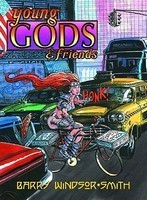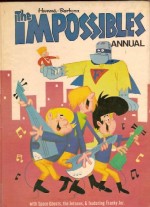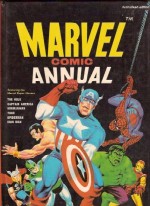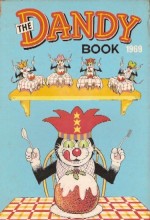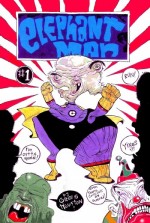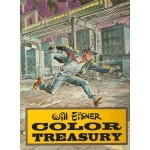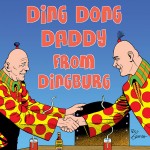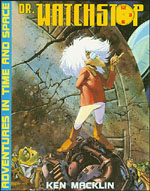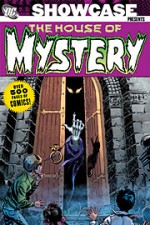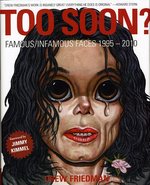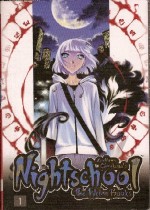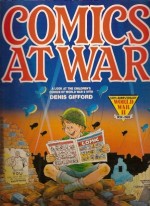
By Denis Gifford (Hawk Books)
ISBN: 978-0-96824-885-6
Often the books we write about our comics are better than the stories and pictures themselves: memorable, intensely evocative and infused with the nostalgic joy that only passing years and selective memory bestows.
That’s not in any way to denigrate or decry the superb works of the countless, generally unlauded creators who brightened the days of generations of children with fantastic adventures and side-splitting gags in those so flimsy, so easily lost and damaged cheap pamphlets, but rather because of an added factor inherent in these commemorative tomes: by their very existence they add the inestimable value and mystery of lost or forgotten treasures into the mix.
A perfect example of this is today’s wonderful item, a copious and huge chronicle released as an anniversary item in 1988 celebrating the wartime delights rationed out to beleaguered British lads and lasses, compiled by possibly the nation’s greatest devotee and celebrant of child-culture.
Denis Gifford was a cartoonist, writer, TV show deviser and historian who loved comics. As both collector and creator he gave his life to strips and movies, acquiring items and memorabilia voraciously, consequently channelling his fascinations into more than fifty books on Film, Television, Radio and Comics; imparting his overwhelming devotion to a veritable legion of fans.
If his works were occasionally short on depth or perhaps guilty of getting the odd fact wrong, he was nevertheless the consummate master of enthusiastic remembrance. He deeply loved the medium in concept and in all its execution, from slipshod and rushed to pure masterpieces with the same degree of passion and was capable of sharing – infecting almost – the casual reader with some of that wistful fire.
With hundreds of illustrative examples culled from his own collection this volume was released to commemorate the outbreak of World War II and revels in the magnificent contribution to morale generated by a battalion of artists and (usually anonymous) writers, covering the output of an industry that endured and persevered under appalling restrictions (paper was a vital war resource and stringently rationed), inciting patriotic fervour and providing crucial relief from the stresses and privation of the times.
Abandoning academic rigour in favour of inculcating a taste of the times this 160 page book reprints complete sample strips of the period beginning with the affable tramps and cover feature of Jester, Basil and Bert (by George Parlett), covering the start of the war in four strips from January to November 1939, before dividing the collection into themed sections such as ‘Be Prepared’ (with examples of Norman Ward’s Home Guard heroes Sandy and Muddy from Knock-Out and John Jukes’ Marmaduke, the Merry Militiaman from Radio Fun.
‘At War With the Army’ displays the ordinary Englishman’s perennial problem with Authority- displaying Koko the Pup and Desperate Dan (by Bob MacGillivray and Dudley Watkins from D.C. Thomsons’ Magic and The Dandy), Weary Willie and Tired Tim (from Chips and superbly rendered by Percy Cocking), as well as stunning two-tone and full colour examples from Tip-Top, The Wonder and others.
‘Tanks a Million!’ finds selections from the height of the fighting, and brings us head-on into the controversial arena of ethnic stereotyping. All I can say is what I always do: the times were different. Mercifully we’ve moved beyond the obvious institutionalised iniquities of casual racism and sexism and are much more tolerant today (unless you’re obese, gay, a smoker or childless and happy about it), but if antiquated attitudes and caricaturing might offend you, don’t read old comics – it’s your choice and your loss.
The strip that started this tirade was an example of Stymie and his Magic Wishbone from Radio Fun (a long-running strip with a black boy-tramp in the tradition of minstrel shows) from a chapter dealing with the comic strip love-affair with armoured vehicles and includes many less controversial examples from Tiger Tim’s Weekly, Knock-Out, Chips and Dandy, featuring stars such as Our Ernie, Our Gang, Stonehenge, Kit the Ancient Brit and Deed-A-Day Danny.
…And if you think we were hard on innocent coloured people just wait till you see the treatment dealt to Germans, Italians and Japanese by our patriotic cartoonists…
‘At Sea with the Navy!’ highlights nautical manoeuvres from Casey Court (Chips, by Albert Pease), Rip Van Wink (Beano, James Crichton), Lt. Daring and Jolly Roger (from Golden, by Roy Wilson, Billy Bunter (Knock-Out, by Frank Minnitt), Hairy Dan (Beano, Basil Blackaller) and Pitch and Toss (Funny Wonder, Roy Wilson again) whilst ‘Sinking the Subs’ takes us below the surface with Our Ernie, Desperate Dan, Koko, Pansy Potter, Alfie the Air Tramp and Billy Bunter.
Britain’s fledgling flying squad takes centre-stage with ‘In the Air with the R.A.F.’ featuring Freddie Crompton’s Tiny Tots, Korky the Cat from Dandy, The Gremlins (Knock-Out, by Fred Robinson) and Koko the Pup.
‘Awful Adolf and his Nasty Nazis!’ demonstrates just what we all thought about the Axis nations and even indulges in some highly personal attacks against prominent personages on the other side beginning with Sam Fair’s riotously ridiculing Addie and Hermy, (Beano‘s utterly unauthorised adventures of Hitler and Goering), whilst Our Ernie, Lord Snooty, Pitch and Toss, Big Eggo (Beano, by Reg Carter), Plum and Duff (Comic Cuts, Albert Pease) and the staggeringly offensive Musso the Wop – He’s a Big-a-Da-Flop, (Beano, Artie Jackson and others) all cheered up the home-front with devastating mockery.
‘Doing Their Bit’ gathers wartime exploits of the nation’s stars and celebrities (turning Britain’s long love affair with entertainment industry stars into another bullet at the Boche. Strips featuring Tommy Handley, Arthur Askey, Charlie Chaplin, Jack Warner, Flanagan and Allen, Haver and Lee, The Western Brothers, Sandy Powell, Old Mother Riley featuring Lucan & McShane, Claude Hulbert, Duggie Wakefield, Joe E. Brown, Harold Lloyd, Lupino Lane and Laurel and Hardy re-presented here were collectively illustrated by Reg and George Parlett, Tom Radford, John Jukes, Bertie Brown, Alex Akerbladh, George Heath, Norman Ward and Billy Wakefield.
The kids themselves are the stars of ‘Evacuation Saves the Nation!’ as our collective banishment of the cities’ children produced a wealth of intriguing possibilities for comics creators. Vicky the Vacky (Magic, George Drysdale), Our Happy Vaccies (Knock-Out, by Hugh McNeill) and Annie Vakkie (Knock-Out, by Frank Lazenby) showed readers the best way to keep their displaced chins up whilst ‘Blackout Blues!’ find the famous and commonplace alike suffering from night terrors.
Examples here include Grandma Jolly and her Brolly, Will Hay, the Master of Mirth, Ben and Bert, Barney Boko, Crusoe Kids, Grandfather Clock, Constable Cuddlecock and Big Ben and Little Len whilst ‘Gas Mask Drill’ sees the funny side of potential asphyxiation with choice strips such as Stan Deezy, Hungry Horace, Deed-A-Day Danny, Big Eggo, Good King Coke and Cinderella.
‘Barrage Balloons!’ lampoons the giant sky sausages that made life tricky for the Luftwaffe with selections from Luke and Len the Odd-Job Men (from Larks by Wally Robertson), It’s the Gremlins, Alfie the Air Tramp, and In Town this Week from Radio Fun, whilst ‘Tuning Up the A.R.P.!’ deals out the same treatment to the volunteers who patrolled our bombed-out streets after dark. The Air Raid Precautions patrols get a right sending up in strips starring Deed-A-Day Danny, Big Eggo, P.C. Penny, Ben and Bert, Marmy and His Ma, Lord Snooty and his Pals, The Tickler Twins in Wonderland, Our Ernie, Tootsy McTurk, Boy Biffo the Brave and Pa Perkins and his Son Percy.
The girls get a go in the vanguard with ‘Wow! Women of War!’ starring Dandy‘s Keyhole Kate and Meddlesome Matty (by Allan Morley and Sam Fair respectively), Dolly Dimple (Magic, Morley again), Tell Tale Tilly, Peggy the Pride of the Force, Pansy Potter the Strongman’s Daughter, Big Hearted Martha Our A.R.P. Nut and Kitty Clare’s Schooldays whilst the Home Guard stumble to the fore once more in a section entitled ‘Doing Their Best’ with examples from Tootsy McTurk (Magic, John Mason), Casey Court, Lord Snooty, Deed-A-Day Danny, and Big Eggo.
Imminent invasion was in the air and the cartoonist responded with measured insolence. ‘Hop It, Hitler!’ displays our fighting spirit with examples such as Bamboo Town (Dandy, Chick Gordon), Sandy and Muddy, Pansy Potter, the astonishingly un-PC Sooty Snowball, Hair-Oil Hal Your Barber Pal and Stonehenge Kit, whilst espionage antics are exposed in ‘I Spy Mit Mein Little Eye!’ in Laurie and Trailer the Secret Service Men, more Sandy and Muddy, Herr Paul Pry, Big Eggo and Lord Snooty.
‘Wireless War!’ celebrates both radio stars and enemy broadcasts with a selection from Tommy Handley, Troddles and his Pet Tortoise Tonky-Tonk, Happy Harry and Sister Sue, Crackers the Perky Pup, Our Gang and a couple of examples of John Jukes’ spectacularly wicked Radio Fun strip Lord Haw-Haw – The Broadcasting Humbug from Hamburg.
‘To Blazes With the Firemen!’ is a rather affectionate and jolly examination of one of the toughest of home-front duties with a selection of strips including Podge (who’s dad was a fire-fighter, drawn by Eric Roberts for Dandy), Casey Court, Pansy Potter and In Town This Week.
Rationing was never far from people’s minds and an art-form where the ultimate reward was usually “a slap-up feed†perfectly lambasted the measures in many strips. Examples here include The Bruin Boys from Tiny Tim’s Weekly, Freddy the Fearless Fly (Dandy, Allan Morley), Cyril Price’s vast ensemble cast from Casey Court (Chips), Our Ernie and Dudley Watkins’ Peter Piper from Magic, all in need of ‘Luvly Grub!’
Under the miscellaneous sub-headings of ‘Salvage’, ‘Comical Camouflage!’, ‘Workers Playtime!’ and ‘Allies’, strips featuring Ronnie Roy the Indiarubber Boy, Ding Dong Dally, Desperate Dan, Tin-Can Tommy the Clockwork Boy, Big Hearted Arthur and Dicky Murdoch and other stalwarts all gather hopeful momentum as the Big Push looms and this gloriously inventive and satisfying compilation heads triumphantly towards its conclusion.
‘V for Victory!’, wherein a telling gallery of strips celebrating the war’s end and better tomorrows features final sallies from Casey Court, Weary Willie and Tired Tim, a stunning Mickey Mouse Weekly cover by Victor Ibbotson, Its That Man Again – Tommy Handley, Laurel and Hardy and from Jingles, Albert Pease has the last word with ‘Charlie Chucklechops Speaking… About New Uses for Old War materials’…
Some modern fans find a steady diet of these veteran classics a little samey and formulaic – indeed I too have trouble with some of the scripts – but the astonishing talents of the assembled artists here just cannot be understated. These are great works by brilliant comic stylists which truly stand the test of time. Moreover, in these carefully selected, measured doses the tales here from a desperate but somehow more pleasant and even enviable time are utterly enchanting. This book is long overdue for a new edition and luckily for you is still available through many internet retailers.
Text and compilation © 1988 Denis Gifford. © 1988 Hawk Books. All rights reserved.
